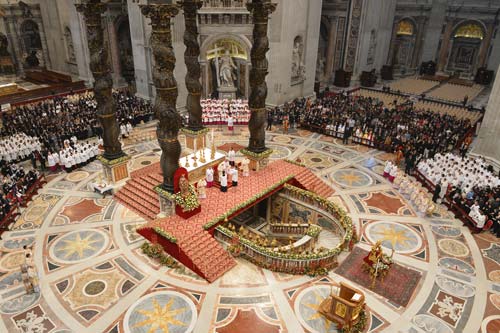Here's a somewhat quick design for the celebration of a Solemnity which we call Sex Capparum on account of requiring six cantors vested in copes (cappae in late Latin).
Sex Capparum is the the term used for the triple celebrations in the Gothispanic and early Mozarabic Rite.
It
entails the decoration of all "three choirs" (the area of the altar,
the area of the choir proper, and the area of the nave) with wall hangings,
carpets, flowers, greenery and whatever else is customary.
The
triple choir refers also to the the fact that "one choir" can mean a
pair of choristers as required for the Memoriae II Capparum and the two pairs required for the Festa IIII Capparum.
Three choirs is generally interpreted as refering to the the three spaces (altar, quire and nave) occupied by the good Christians, but also the three pairs of choristers that from the north and south, facing each other, will sing the complex melodies of the celebration of a Solemnia VI Capparum.
Three choirs is generally interpreted as refering to the the three spaces (altar, quire and nave) occupied by the good Christians, but also the three pairs of choristers that from the north and south, facing each other, will sing the complex melodies of the celebration of a Solemnia VI Capparum.
For the solemnities, it is these six members of the chapel who vest in copes who are in charge of the melismatic singing peculiar to the Rite and is known as Eugenian or Melodic Chant.
The difference between our Eugenian Chant and the Gregorian Chant of the Roman Rite is the profusion of melesmas or florid adornment during sung vowels. In Gregorian Chant one sings many syllables on one note, whereas we sing many notes for each syllable. (Think of the word Gloria from the tune of "Angels We Have Heard On High" as an example of our melodic chant... as it heralds from Languedoc, our Provincia Narbonensis!)
The image, besides the position of the six Caperos that constitute the triple choir, shows the relative positions of the Lector, Subdeacon, and Deacon
for their respective readings.
The celebrant seats "ante altare" since
the curtains to the altar are open from the beginning of vespers which
is the start of the Liturgical Day on account of the mass not being a Feria.
This allows the deacon to occupy the central tribune (aka pulpitum in Latin or chaire in French) near the altar which is where the celebrant seats when the altar remains
veiled on the Feriae until the Sacrificium (which is the equivalent of the roman Offertory).
The Lector and the Subdeacon reads the first two of the three readings, the Prophetia and Apostolus, while standing on escabeles - small movable steps which raise them somewhat to be better heard by the people beyond the chancels of the roodscreen. As we discussed here, the roodscreen is in Germany called the lettner, for it was from here that the readings took place. In the Use of Sarum, albeit with its variations, this was also observed:
In the middle of the choirs ("in medio chori") stands the bema (another movable tribune) with the object of the celebration - be it icon, image, baptismal font, bride-and-groom, catafalque, ordinant, or the Gospels as in the Feriae.
In this case it is a representation of the newborn Jesus in a Manger, which tells us that the scene is during the readings preceding the Mass of the Nativity on Christmas Eve. Something of this use can still be seen in the mass at Saint Peter's Basilica at least on Christmas albeit not being the most common thing to see in the Roman Rite:



And the eastern orthodox churches also still place icons in this position to this day.
This set up is for public worship at a parish church, since architecture determined the degree of architecture allowed, the form and rubrics to be followed. We have worked on a book on just these peculiarities of the Gothispanic Rite and early Mozarabic which did not survive past the reforms of the Cardinal Cisneros onto the Hispano-Mozarabic Rite celebrated in Toledo today, though vestiges of them dot the particular uses of many of the Hispanic provinces even though they follow the Roman Rite.
Get a copy! Just click on the Book cover and then you know the steps. Ultimately, 20% of all Profits go to Charity. The rest, to fund research for future tomes and translations.
Many thanks for your interest and support!
Many thanks for your interest and support!







